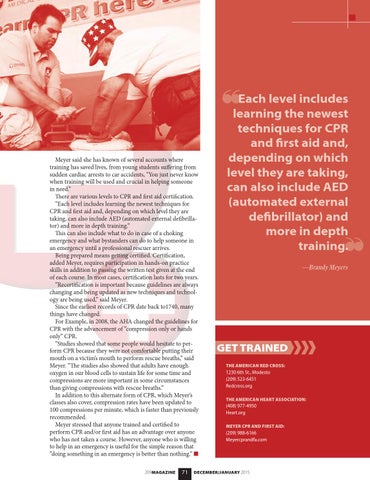Each level includes ❝learning the newest
Meyer said she has known of several accounts where training has saved lives, from young students suffering from sudden cardiac arrests to car accidents, “You just never know when training will be used and crucial in helping someone in need.” There are various levels to CPR and first aid certification. “Each level includes learning the newest techniques for CPR and first aid and, depending on which level they are taking, can also include AED (automated external defibrillator) and more in depth training.” This can also include what to do in case of a choking emergency and what bystanders can do to help someone in an emergency until a professional rescuer arrives. Being prepared means getting certified. Certification, added Meyer, requires participation in hands-on practice skills in addition to passing the written test given at the end of each course. In most cases, certification lasts for two years. “Recertification is important because guidelines are always changing and being updated as new techniques and technology are being used,” said Meyer. Since the earliest records of CPR date back to1740, many things have changed. For Example, in 2008, the AHA changed the guidelines for CPR with the advancement of “compression only or hands only” CPR. “Studies showed that some people would hesitate to perform CPR because they were not comfortable putting their mouth on a victim’s mouth to perform rescue breaths,” said Meyer. “The studies also showed that adults have enough oxygen in our blood cells to sustain life for some time and compressions are more important in some circumstances than giving compressions with rescue breaths.” In addition to this alternate form of CPR, which Meyer’s classes also cover, compression rates have been updated to 100 compressions per minute, which is faster than previously recommended. Meyer stressed that anyone trained and certified to perform CPR and/or first aid has an advantage over anyone who has not taken a course. However, anyone who is willing to help in an emergency is useful for the simple reason that “doing something in an emergency is better than nothing.” ■ 209MAGAZINE
71
techniques for CPR and first aid and, depending on which level they are taking, can also include AED (automated external defibrillator) and more in depth training.
❝
—Brandy Meyers
GET TRAINED THE AMERICAN RED CROSS: 1230 6th St., Modesto (209) 523-6451 Redcross.org THE AMERICAN HEART ASSOCIATION: (408) 977-4950 Heart.org MEYER CPR AND FIRST AID: (209) 988-6166 Meyercprandfa.com
DECEMBER/JANUARY 2015
